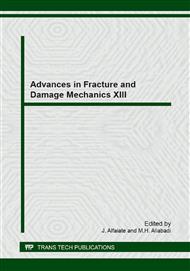p.313
p.317
p.321
p.325
p.329
p.333
p.337
p.341
p.345
Microindentation Test Modelling in the Silicon Nitride Ceramics by Application of the Cohesive Zone Approach
Abstract:
Silicon nitride based ceramics have received considerable attention during the last decades due to their very good room and high-temperature properties. Ceramics such as silicon nitride (Si3N4) are acknowledged as first choice for modern bearing applications. The influence of grain bridging on the strength and toughness was found. The prediction of crack propagation through interface elements based on the fracture mechanics approach and cohesive zone model is investigated from amount damage models. Using cohesive models the behaviour of materials is realized by two types of elements. The former is the element for classical continuum and the latter is the connecting cohesive element. Within the standard finite element package Abaqus the new finite element has been developed; it is written via the UEL procedure. The shape of the traction separation law for experimental materials is estimated from macroscopic tests, J–R curve is predicted and stability of the bridging law is tested. The shape of the bridging law is verified using the microindentation test, where the maximum crack length not exceeded 150 μm. The scope of the bridging effect is verified using the standard XFEM elements implemented in Abaqus.
Info:
Periodical:
Pages:
329-332
Citation:
Online since:
September 2014
Authors:
Price:
Сopyright:
© 2015 Trans Tech Publications Ltd. All Rights Reserved
Share:
Citation:


